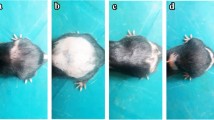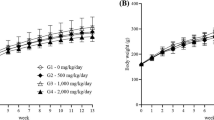Abstract
To clarify the question of clastogenicity of aniline in rats two studies were performed: a bone marrow micronucleus test and a bone marrow metaphase test. In the micronucleus test aniline (as aniline hydrochloride) was administered to groups of seven male PVG rats at single oral doses of 0, 300, 400, or 500 mg/kg body weight. Bone marrow was obtained 24 and 48 h after oral treatment. Smears of bone marrow were stained with acridine orange and erythrocytes were examined for the presence of micronuclei. Animals receiving cyclophosphamide (1×7.5 mg/kg) served as positive controls. Clinical signs observed in animals dosed at 300 mg/kg and above included cyanosis, light brown coloured urine and cold to touch. Small, but statistically significant and dose-related increases in the incidence of micronulei over the vehicle control values were observed at the 24-h sampling time only. Cyclophosphamide induced a significant and comparably much higher increase in micronuclei than aniline. In the bone marrow metaphase test aniline (as aniline hydrochloride) was administered to groups of seven male PVG rats at single oral dose levels of 0, 300, 400, or 500 mg/kg body weight. Bone marrow was sampled 18 and 30 h after dosing. A group treated with cyclophosphamide (1×40 mg/kg) served as positive control. A small increase in the percentage of aberrant cells above solvent control values was recorded in one rat at 400 mg/kg and four rats at 500 mg/kg at the 18-h sampling time only. The positive control cyclophosphamide induced a much higher rate of aberrant cells in all animals. Several lines of evidences are presented against a causal relationship between the clastogenic activity in male PVG rats at 400 and 500 mg/kg and the carcinogenicity in the spleen of Fischer 344 rats starting at 30 mg/kg in males. Among these are the dose-response relationship of the tumour incidence, the close correlation between degree of spleen damage and tumour induction, the lack of carcinogenic effects in mice even at higher dose levels, or in rats at dose levels inducing only slight haematotoxicity and spleen toxicity, and the available data on the mode of action of other chemicals inducing spleen tumours.
Similar content being viewed by others
References
Anonymous (1988) Final report on the safety assessment of p-aminophenol, m-aminophenol, and o-aminophenol. J Am Coll Toxicol 7:279–333
Anonymous (2001) Aniline: acute exposure guideline levels. Inhal Toxicol 13 [Suppl]:7–42
Ashby J, Vlachos DA, Tinwell H (1991) Activity of aniline in the mouse bone marrow micronucleus assay. Mutat Res 263:115–117
BG Chemie (1985) Mouse micronucleus test on aniline. Toxicol. Report Ref. No. 54/8505, October 1985
Bus JS, Popp JA (1987) Perspectives on the mechanisms of action of the splenic toxicity of aniline and structurally related compounds. Food Chem Toxicol 25:619–626
Cesarone CF, Bolognesi C, Santi L (1982) Evaluation of damage to DNA after in vivo exposure to different classes of chemicals. Arch Toxicol Suppl 5:355–359
Ciccoli L, Ferrali M, Rossi V, Signorini C, Alessandrini C, Comporti M (1999) Hemolytic drugs aniline and dapsone induce iron release in erythrocytes and increase the free iron pool in spleen and liver. Toxicol Lett 110:57–66
CIIT (Chemical Industry Institute of Toxicology) (1982) 104-Week chronic toxicity study in rats: aniline hydrochloride. Final report. CIIT, Research Triangle Park NC
Deguchi J, Miyamaoto M, Okada S (1995) Sex hormone-dependent renal cell carcinogenesis induced by ferric nitrilotriacetate in Wistar rats. Jpn J Cancer Res 86:1068–1071
Fox V (2001) Aniline hydrochloride rat bone marrow micronucleus test. Report of Central Toxicology Laboratory, Syngenta
Freeman MF, Tukey JW (1950) Transformations related to the angular and the square root. Ann Maths Stats 21:607–611
George E, Andrews M, Westmoreland C.(1990) Effects of azobenzene and aniline in the rodent bone marrow micronucleus test. Carcinogenesis 11:1551–1555
Goodman DG, Ward JM, Reichardt WD (1984) Splenic fibrosis and sarcomas in F344 rats fed diets containing aniline hydrochloride, p-chloroaniline, azobenzene, o-toluidine hydrochloride, 4,4'-sulfonyldianiline, or D & C Red No. 9. J Natl Cancer Inst 73:265–273
Harper BL, Ramanujam VMS, Gad-El-Karim MM, Legator MS (1984) The influence of simple aromatics on benzene clastogenicity. Mutat Res 128:105–114
Harrison JH Jr, Jollow J (1987) Contribution of aniline metabolites to aniline-induced methemoglobinemia. Mol Pharmacol 32:423–431
IARC (International Agency for Research on Cancer) (1982) IARC Monographs on the evaluation of the carcinogenic risk of chemicals to humans. Some aromatic amines, anthraquinones and nitroso compounds, and inorganic fluorides used in drinking-water and dental preparations, vol 27. IARC Press, Lyon, pp 39–61
Jenkins FP, Robinson JA, Gellatly JBM, Salmond GWA (1972) The no-effect dose of aniline in human subjects and a comparison of aniline toxicity in man and rat. Food Cosmet Toxicol 10:671–679
Jones E, Fox V (2003) Lack of clastogenic activity for aniline hydrochloride in the mouse bone marrow. Mutagenesis (in press)
Khan MF, Kaphalia BS, Ansari GAS (1997a) Acute hematopoietic toxicity of aniline in rats. Toxicol Lett 92:31–37
Khan MF, Boor PJ, Gu Y, Alcock NW, Ansari GAS (1997b) Oxidative stress in the splenotoxicity of aniline. Fundam Appl Toxicol 35:22–30
Khan MF, Green SM, Ansari GAS, Boor PJ (1998) Phenylhydroxylamine: role of aniline-associated splenic oxidative stress and induction of subendocardial necrosis. Toxicol Sci 42:64–71
Khan MF, Wu X, Alcock NW, Boor PJ, Ansari GAS (1999a) Iron exacerbates aniline-associated splenic toxicity. J Toxicol Environ Health A 57:173–184
Khan MF, Wu X, Boor PJ, Ansari GAS (1999b) Oxidative modification of lipids and proteins in aniline-induced splenic toxicity. Toxicol Sci 48:134–140
Khan MF, Wu X, Ansari GAS (2000) Contribution of nitrosobenzene to splenic toxicity of aniline. J Toxicol Environ Health A 60:263–273
Maples KR, Eyer P, Mason RP (1990) Aniline-, phenylhydroxylamine-, nitrosobenzene-, and nitrobenzene-induced hemoglobin thiyl free radical formation in vivo and in vitro. Mol Pharmacol 37:311–318
McCarthy DJ, Waud WR, Struck RF, Hill DL (1985) Disposition and metabolism of aniline in Fischer 344 rats and C57BL/6 × C3H F1 mice. Cancer Res 45:174–180
NCI (National Cancer Institute) (1978) Bioassay of aniline hydrochloride for possible carcinogenicity. National Toxicology Program Technical Report Series No. 130. US Department of Health, Bethesda
Parodi S, Taningher M, Russo P, Pala M, Tamaro M, Monti-Bragadin C (1981) DNA-damaging activity in vivo and bacterial mutagenicity of sixteen aromatic amines and azo-derivatives, as related quantitatively to their carcinogenicity. Carcinogenesis 2:1317–1326
Parodi A, Pala M, Russon P, Zunino A, Balbi C, Albini A, Valerio F, Cimberle MR, Santi L (1982) DNA damage in liver, kidney, bone marrow, and spleen of rats as determined by alkaline elution assay and sister chromatid exchange induction. Cancer Res 42:2277–2283
Pence DH, Schnell RC (1979) Sex-related differences in biotransformation of aniline hydroxylase in Sprague-Dawley rats. Pharmacology 18:52–56
Ress BR, Witt KL, Xu J, Haseman JK, Bucher JR (2002) Micronucleus induction in mice exposed to diazoaminobenzene or its metabolites, benzene and aniline: implications for diaminoazobenzene carcinogenicity. Mutat Res 521:201–208
Roberts JJ, Warwick,GP (1966) The covalent binding of metabolites of dimethylamino-azobenzene, β-naphthylamine and aniline to nucleic acids in vivo. Int J Cancer 1:179–196
Sasaki YF, Fujikawa K, Ishida K, Kawamura N, Nishikawa Y, Ohta S, Satoh M, Madarame H, Ueno S, Susa N, Matsusaka N, Tsuda S (1999) The alkaline single gel electrophoresis assay with mouse multiple organs: results with 30 aromatic amines evaluated by the IARC and U.S. NTP. Mutat Res 440:1–18
Scott D, Danford ND, Dean BJ, Kirkland DJ (1990) Metaphase chromosome aberration assays in vitro. In: Kirkland DJ (ed) Basic mutagenicity tests: UKEMS recommended procedures. Cambridge University Press, Cambridge, pp 62–86
Sekihashi K, Yamamoto A, Matsumura Y, Ueno S, Watanabe-Akanuma M, Kassie F, Knasmüller S, Tsuda S, Sasaki YF (2002) Comparative investigation of multiple organs of mice and rats in the comet assay. Mutat Res 517:53–75
Sicardi SM, Martarena JL, Iglesias MT (1991) Mutagenic and analgesic activities of aniline derivatives. J Pharm Sci 80:761–764
Smith RP, Alkaitis AA, Shafer PR (1967) Chemically induced methemoglobinemias in the mouse. Biochem Pharmacol 16:317–328
Tinwell H, Ashby J (1991) Micronucleus morphology as a means to distinguish aneugens and clastogens in the mouse bone marrow micronucleus assay. Mutagenesis 6:193–198
Vlachos DA (1989) Mouse bone marrow micronucleus assay of aniline. Report No. 263-89; DuPont HLR, Haskell Laboratory of Toxicology and Industrial Medicine, Newark
Weinberger MA, Albert RH, Montgomery SB (1985) Splenotoxicity associated with splenic sarcomas in rats fed high doses of D & C Red No. 9 or aniline hydrochloride. J Natl Cancer Inst 75:681–687
Weisburger JH, Weisburger EK, Madison RM, Wenk ML, Klein DS (1973) Effect of acetanilide and p-hydroxyacetanilide on the carcinogenicity of N-2-fluorenylacetamide and N-hydroxy-N-2-fluorenylacetamide in mice, hamsters, and female rats. J Natl Cancer Inst 51:235–240
Westmoreland C, Gatehouse DG (1991) Effects of aniline hydrochloride in the mouse bone marrow micronucleus test after oral administration. Carcinogenesis, 12:1057–1059
Witt KL, Knapton A, Wehr CM, Hook GJ, Mirsalis J, Shelby MD, MacGregor JT (2000) Micronucleated erythrocyte frequency in peripheral blood of B6C3F1 mice from short-term, prechronic, and chronic studies of the NTP carcinogenesis bioassay program. Environ Mol Mutagen 36:163–194
Acknowledgements
The author is grateful to Drs. Rudolf Jäckh and Lawrence Segal for helpful discussions. The experiments have been performed at the Central Toxicology Laboratory of Syngenta, Macclesfield,UK (Study Director: Mrs. V. Fox) and were sponsored jointly by BASF AG (Germany), Bayer AG (Germany) and Huntsman Polyurethanes (Belgium).
Author information
Authors and Affiliations
Corresponding author
Rights and permissions
About this article
Cite this article
Bomhard, E.M. High-dose clastogenic activity of aniline in the rat bone marrow and its relationship to the carcinogenicity in the spleen of rats. Arch Toxicol 77, 291–297 (2003). https://doi.org/10.1007/s00204-003-0443-1
Received:
Accepted:
Published:
Issue Date:
DOI: https://doi.org/10.1007/s00204-003-0443-1




